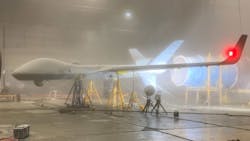Protector RPA Passes System-Level Testing
The Protector, a remotely piloted aircraft (RPA) being developed by General Atomics Aeronautical Systems, Inc., recently completed key system-level tests, keeping the RPA on schedule to become the world’s first certified medium-altitude, long-endurance (MALE) RPA. The Protector RG Mk1 RPA (see the figure) is the United Kingdom (UK) Royal Air Force (RAF) version of the MQ-9B SkyGuardian® RPA. Recent testing included full-scale static (FSS) strength, high-intensity radiated frequency (HIRF), and environmental testing. The first Protector is expected to complete final testing and evaluations in late 2022 and arrive in the UK in 2023.
RAF Group Captain Shaun Gee, Director Air ISTAR Programmes (RPAS and TacISR) and SRO Shadow Programme, said: “It’s exciting to see the progress of the Protector Program. GA-ASI has provided support, not only in the testing of the aircraft, but in developing the game-changing RPA platform.” Gee added: “GA-ASI provided a company MQ-9B over this past summer and operated it from RAF bases in the UK to help us get acquainted with its operational capabilities ahead of the first delivery of Protector.”
During FSS testing, multiple stress forces within 150% of the highest operating loads were placed on the full fuselage, wings, tails, and landing gear to evaluate the RPA’s airworthiness for UK missions as well as in international airspace. HIRF testing was conducted at the Electromagnetic Environmental Effects (E3) Test Facility at the Naval Air Station Patuxent River. The aircraft was exposed to high-intensity electromagnetic (EM) radiation, including hazards of electromagnetic radiation on ordnance (HERO) testing to evaluate the effects of EH radiation on weapons systems. Environmental testing, which was performed at Eglin Air Force Base, subjected the aircraft to extreme temperatures, such as -33°C, supercooled fog, high humidity, and high temperatures.
“These critical system-level tests prove the safety and reliability of our aircraft to operate in extreme climates and electromagnetic environments,” said Chris Dusseault, senior director for the Protector RPAS at GA-ASI. “We’re proud to see the design concepts of MQ-9B be proven in operational environments bringing the Protector system one step closer to fielding with our RAF partner.”
About the Author
Jack Browne
Technical Contributor
Jack Browne, Technical Contributor, has worked in technical publishing for over 30 years. He managed the content and production of three technical journals while at the American Institute of Physics, including Medical Physics and the Journal of Vacuum Science & Technology. He has been a Publisher and Editor for Penton Media, started the firm’s Wireless Symposium & Exhibition trade show in 1993, and currently serves as Technical Contributor for that company's Microwaves & RF magazine. Browne, who holds a BS in Mathematics from City College of New York and BA degrees in English and Philosophy from Fordham University, is a member of the IEEE.
